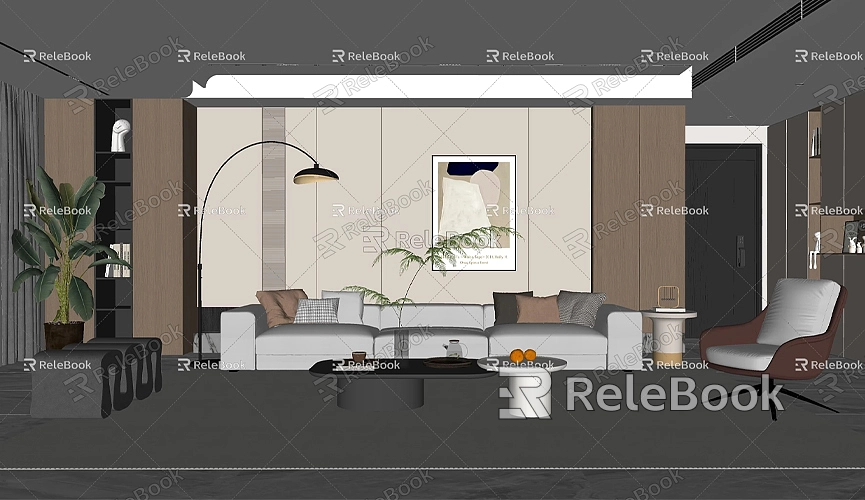How to Import a SketchUp Model
SketchUp is a widely used 3D modeling software, favored by architects, interior designers, landscape architects, and urban planners for its user-friendly interface and powerful features. Its simplicity and versatility have made it a favorite tool for many designers and artists. In practice, it’s often necessary to import SketchUp models into other platforms or software for further processing and rendering, such as Blender, 3ds Max, or Unreal Engine. This article will provide a detailed guide on how to import SketchUp models, including common import methods, key considerations, and solutions to common problems.
Why Import SketchUp Models?
In the design process, SketchUp helps us quickly create 3D models, but sometimes we need to import these models into other, more specialized software for fine-tuning, rendering, or animation work. Different software programs offer distinct advantages—for example, Blender excels at animation and rendering, 3ds Max has powerful features for architectural visualization, and Unreal Engine is an essential tool for game development.

By importing SketchUp models into these tools, designers can better integrate their designs into professional workflows, enhancing the overall quality of the project. Therefore, mastering how to correctly import SketchUp models is a crucial skill for any 3D designer.
Common Methods for Importing SketchUp Models
Before importing your SketchUp model into other software, it’s important to ensure that the model is of high quality and compatible with the software you plan to use. Below are several common import methods, each with its own characteristics and appropriate use cases.
1. Exporting as STL Format (Ideal for 3D Printing and Simple 3D Processing)
STL is a common file format for 3D printing, capable of saving the geometry of a model effectively. It’s a good choice for 3D printing or for simply viewing the model in 3D. The steps to export an STL file from SketchUp are as follows:
- Open your SketchUp model and select the parts you wish to export.
- Click on the “File” menu and choose “Export.”
- In the export dialog, select the “STL” format and choose a save location.
- Once exported, you can open the STL file in your 3D printing software.
STL files are excellent for 3D printing and basic 3D views, but they don’t support textures or color information. If you need a higher-quality import, you might want to consider other formats.
2. Exporting as OBJ Format (Ideal for High-Quality Rendering and Detail Work)
The OBJ format is a widely used 3D model exchange format that preserves both geometry and texture information well. If you plan to import your SketchUp model into Blender or 3ds Max for more complex rendering or animation, OBJ is an ideal choice.
The steps to export an OBJ file from SketchUp are as follows:
- Open your SketchUp model and ensure all design work is complete.
- Click on the “File” menu and select “Export.”
- Choose the “OBJ format” option from the export settings.
- Select the save location and click “Save.”
When exporting an OBJ file, SketchUp automatically generates a file with the geometry, and any textures or materials will be saved as separate files. You can then import these files into other software for further processing.
3. Exporting as FBX Format (Ideal for Animation and Game Engines)

The FBX format, developed by Autodesk, is widely used in game development and animation production. It not only preserves the geometry of the 3D model but also supports textures, materials, animations, and camera settings. If you need to import your SketchUp model into a game engine like Unity or Unreal Engine, FBX is the most suitable option.
To export an FBX file from SketchUp, follow these steps:
- Open your SketchUp model.
- Select the “File” menu and click on “Export.”
- Choose the FBX format from the export options and configure any necessary export settings.
- Save the file and open it in your target software.
The advantage of FBX is that it can preserve more details, such as skeletons and animations, making it ideal for projects that require high-quality rendering or animation.
4. Using Plugins to Import into Other Software
In addition to directly exporting files, SketchUp also offers plugins that can help you import models into other software. For example, if you want to import your SketchUp model into Blender, you can use a SketchUp import plugin for Blender. This plugin ensures that the model’s integrity and scale are better maintained.
The SketchUp import plugin for Blender allows you to import models into Blender with the correct scale and retain textures and materials. You simply need to install the plugin in Blender and then choose the SketchUp file to import from Blender’s “File” menu.
Common Issues When Importing and How to Fix Them
While importing SketchUp models, you might encounter some common issues. Below are a few potential problems and their solutions.
1. Incorrect Scale
Sometimes, the model’s scale may change when importing it, especially when exporting from SketchUp to other software. To avoid this, make sure the unit settings match between SketchUp and the target software. If you’re exporting STL, OBJ, or FBX files, double-check the unit settings in the target software and adjust as needed.
2. Missing Textures
Textures might be lost during the export process, particularly when exporting OBJ or FBX files. To prevent this, ensure that the texture paths are correct and that all texture files are saved properly. Some software may require you to manually relink textures when importing OBJ or FBX files.
3. Unable to Open the File
If you find that the exported file cannot be opened in the target software, it could be due to file format incompatibility or issues during export. In this case, try using a different export format or update the relevant software and plugins.
4. Loss of Model Detail
When importing complex SketchUp models into other software, details might be lost. This is typically because the export settings were not set to high quality. To prevent this, consider selecting higher resolution settings during export, or use a format like FBX that supports more detailed imports.
Tips for Improving the Imported SketchUp Model
The quality of the imported model not only depends on the export format but also on the quality of the original SketchUp model. Here are some tips to improve the quality of your imported model:
- Use High-Quality Textures: The texture quality in your model directly impacts the final rendering effect. If you need high-quality 3D textures or HDRI for your models and virtual scenes, you can download them for free from [Relebook Textures](https://textures.relebook.com/). For beautiful 3D models, check out [Relebook 3D Models](https://3dmodels.relebook.com/), which offers a wide range of high-quality resources.
- Optimize Polygon Count: In SketchUp, reduce unnecessary polygon faces to speed up the import process and reduce computational load.
- Split Complex Models: For very complex models, consider splitting them into smaller parts to make them easier to process in other software.
Importing SketchUp models into other software is a common step in 3D design workflows. Mastering the right import methods and techniques can not only improve efficiency but also ensure that your models display the best possible results in the target software. From STL to OBJ to FBX, each export method has its specific use case, and selecting the right format is crucial for subsequent rendering, animation, and game development. We hope this guide helps you better understand how to import SketchUp models and apply these techniques with confidence in your work.
If you need high-quality 3D textures and HDRI for your models and virtual scenes, you can download them for free from [Relebook Textures](https://textures.relebook.com/). If you need beautiful 3D models, check out [Relebook 3D Models](https://3dmodels.relebook.com/), which offers a large collection of premium 3D resources.

